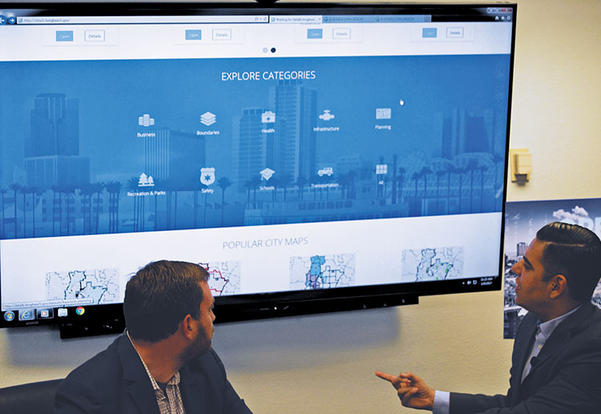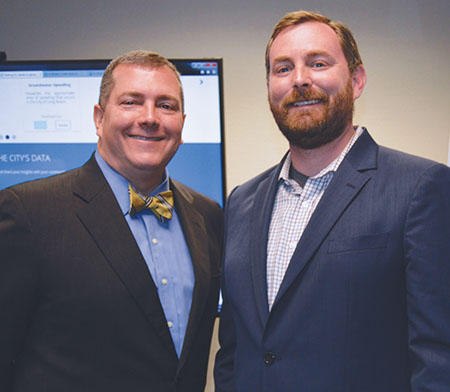Along with his push to keep Long Beach at the forefront of eco-friendly cities (ranked 24th on WalletHub’s 2016 list of greenest U.S. cities), Mayor Robert Garcia has been adamant in ensuring the city is a pioneer for new technologies.

Mayor Robert Garcia, pictured above, unveiled DataLB, the city’s new open data platform, on January 9. Developed by Esri, a Redlands-based geographic information system company, DataLB allows for city data to be displayed on maps of the city. DataLB allows users to browse nine different data categories, with a total of 78 datasets as of January 13. (Photograph by the Business Journal’s Larry Duncan)
To aid in this goal, Garcia created the Long Beach Technology and Innovation Department (TID), led by Director Bryan Sastokas, as well as the Innovation Team (i-team). Months after the launch of BizPort, an online portal developed by the i-team to assist small businesses, the TID launched its open data platform, DataLB, on January 9.
“It is taking open data into the next level in my mind because it’s not just the simple sharing of data,” Sastokas said. “This new portal will allow you to get away from the people that are data wonks and allow our residents access to data that they can manipulate online so they can see it in a graphical representation.”
The data is represented on the website in tables, charts and most importantly maps. The open data provides information on business licensing and the locations of government buildings, post offices, police and fire stations, even golf courses. The platform also displays data such as where Measure A dollars are being spent, pavement conditions and Long Beach Gas and Oil numbers and projects.
“Whether a lot of people care about open data or not, I think it’s just one of those things that the city is obligated to do,” Sastokas said. “We need to give out information. Information should be shared, and as it’s available, it will be posted.”
Sastokas explained that the open data platform is still a work in progress and is continuously being brought as up to date as possible. Eventually, each city department will gain access to update relevant data more efficiently.

Pictured at left are Bryan Sastokas, left, director of the Long Beach Technology and Innovation Department, and Robb Korinke, Long Beach Technology and Innovation Commission chair. (Photographs by the Business Journal’s Larry Duncan)
The city partnered with Esri, a Redlands-based geographic information system company, to develop DataLB. Sastokas said the city pays the company about $180,000 annually for its services, including the development of DataLB.
Now that DataLB has launched, Sastokas said residents will begin to see a shift toward more city investment in cybersecurity initiatives, which could see certain employment positions being phased out.
“We’re trying to be one of the first cities to adopt artificial intelligence framework around security. I believe that a lot of these C-suite roles are going to be phased out as technology changes,” Sastokas said. “I don’t think you always need a security officer or a data officer. A position we’re currently recruiting for – and I think it might be one of the first in the nation – is cyber risk officer.”
As technology moves forward in Long Beach, Sastokas said city officials are hoping to keep the community engaged and will push for as much input as it can get. He explained that he likes to hear ideas from the community because innovative technology is only worth the investment if people use it.
“We want Long Beach to sort of be the test bed for these sorts of technologies because we have a very smart community,” Sastokas said. “[With] that ecosystem, if you foster it, I think we have a chance to show up places like Silicon Valley. We’re Long Beach. We’re going to be innovative in our own right. And I think that’s something you’re going to see from us in 2017.”
